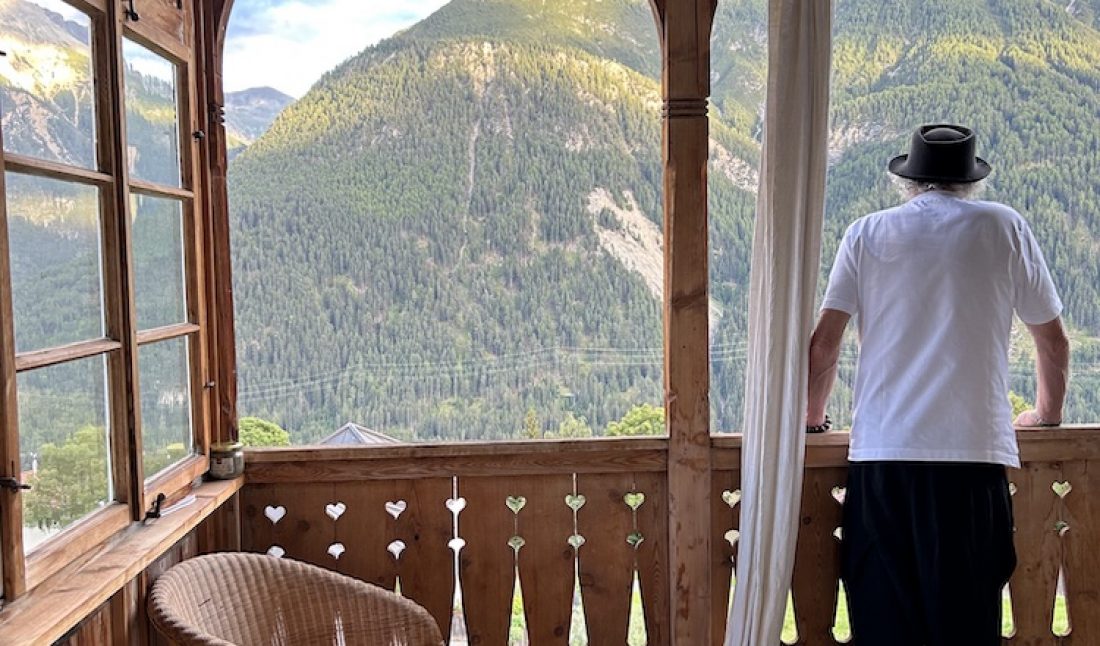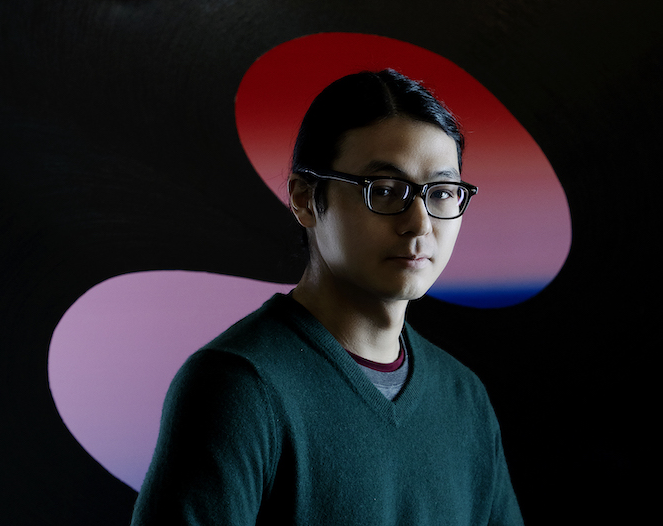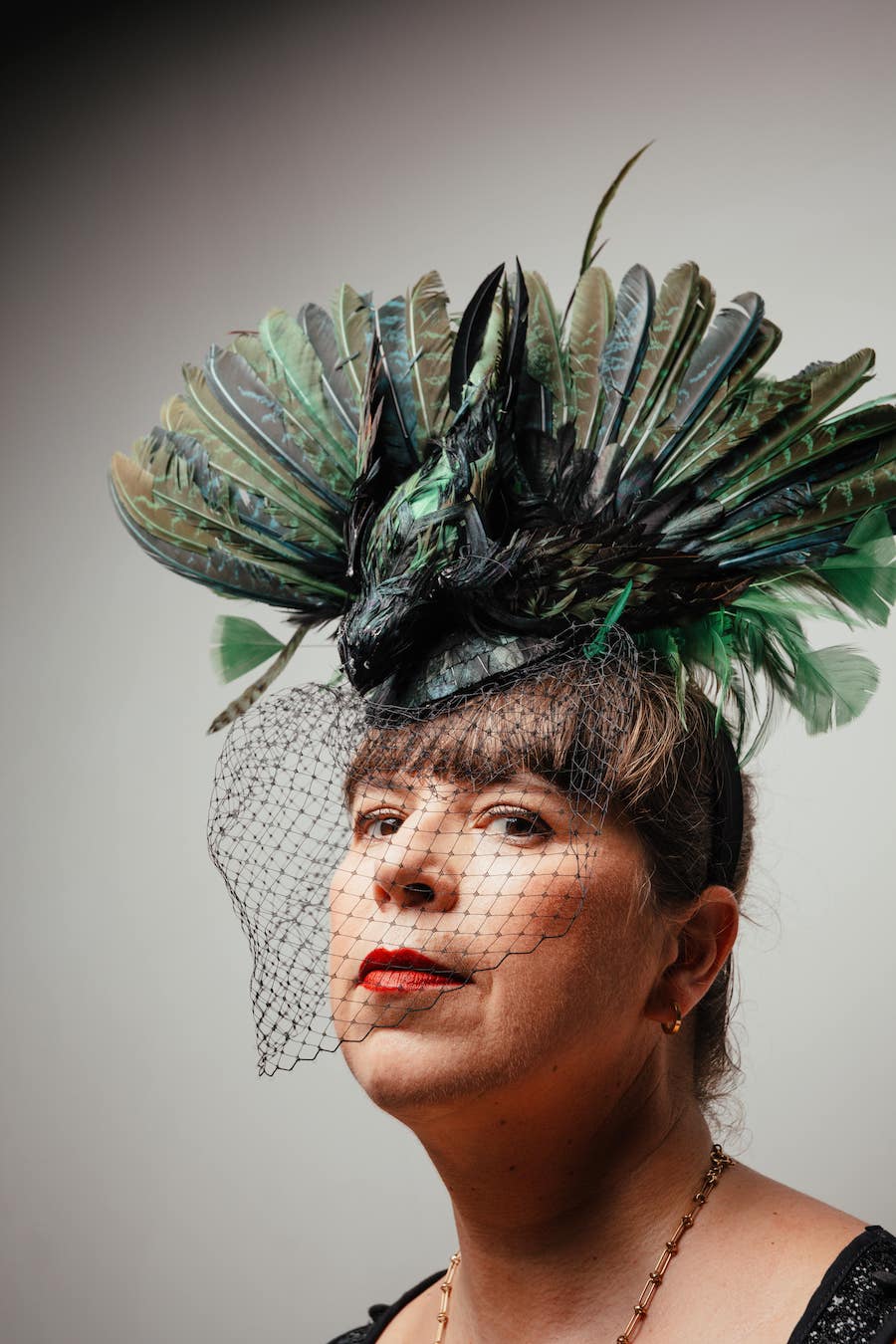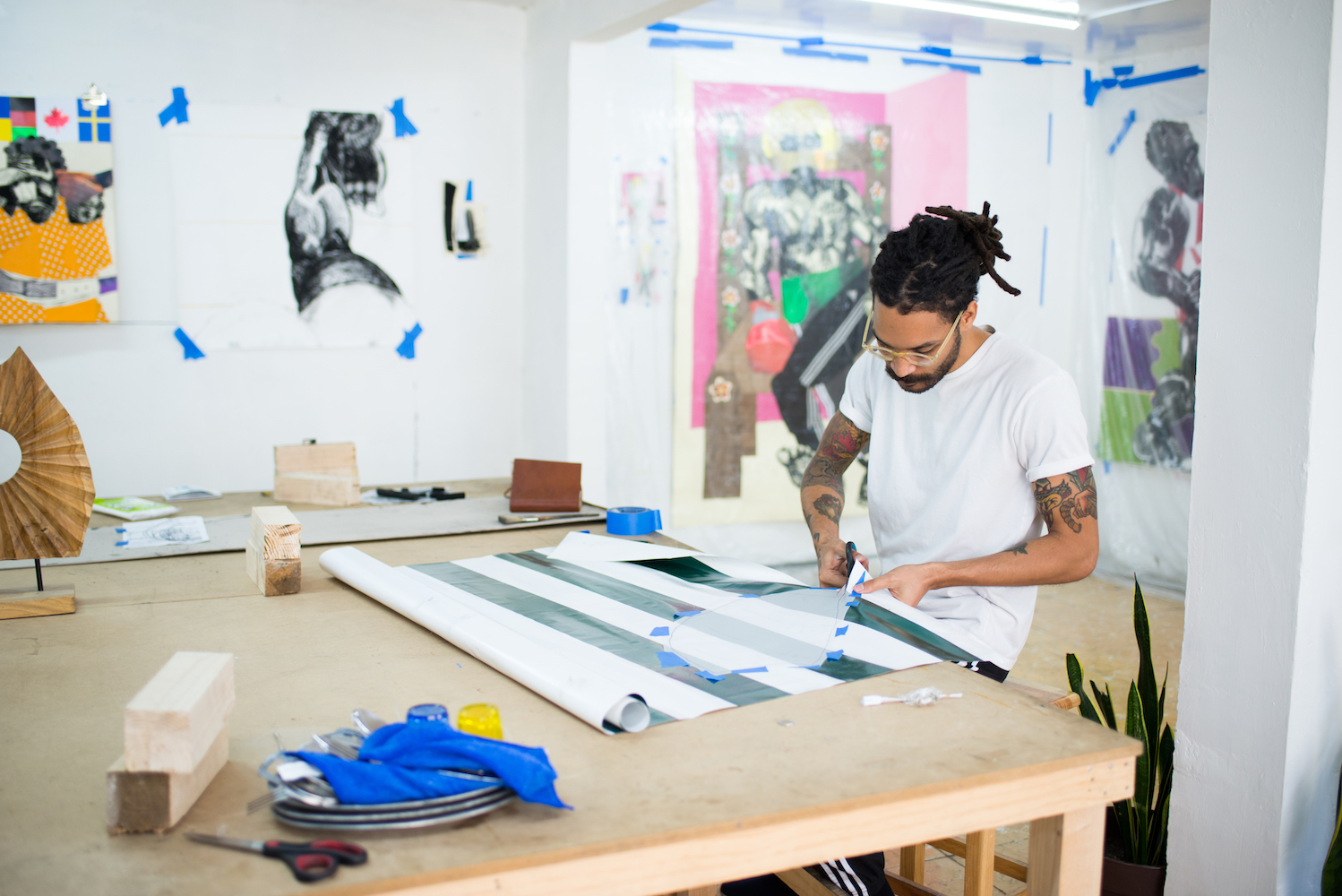Last month, the launch of Swiss artist Not Vital’s first authoritative book, Sculpture, by Alma Zevi was celebrated with a weekend in full immersion of his magical world. It was organized around the spectacular landscape of Engadin, Switzerland home of the Not Vital Foundation and Sculptural Park.
The days were filled with walks, talks, dinners, traditional dances, and impromptu meetings in the inspiring company of Not Vital, Zevi, and their extensive entourage of fellow artists, gallerists, museum curators, journalists, and friends. They gathered around the artist’s studio, his park, and his castle, where multiple conversations arose, including this one here. What started at his house in Scent, in the frame of a typical wooden bow window facing the Italian and Austrian Alps, ended in his car, in motion. This nomadic exchange focused on the extraordinary life-long relationship Not Vital and Zevi have, and their personal ideas of home, identity, and nomadism.
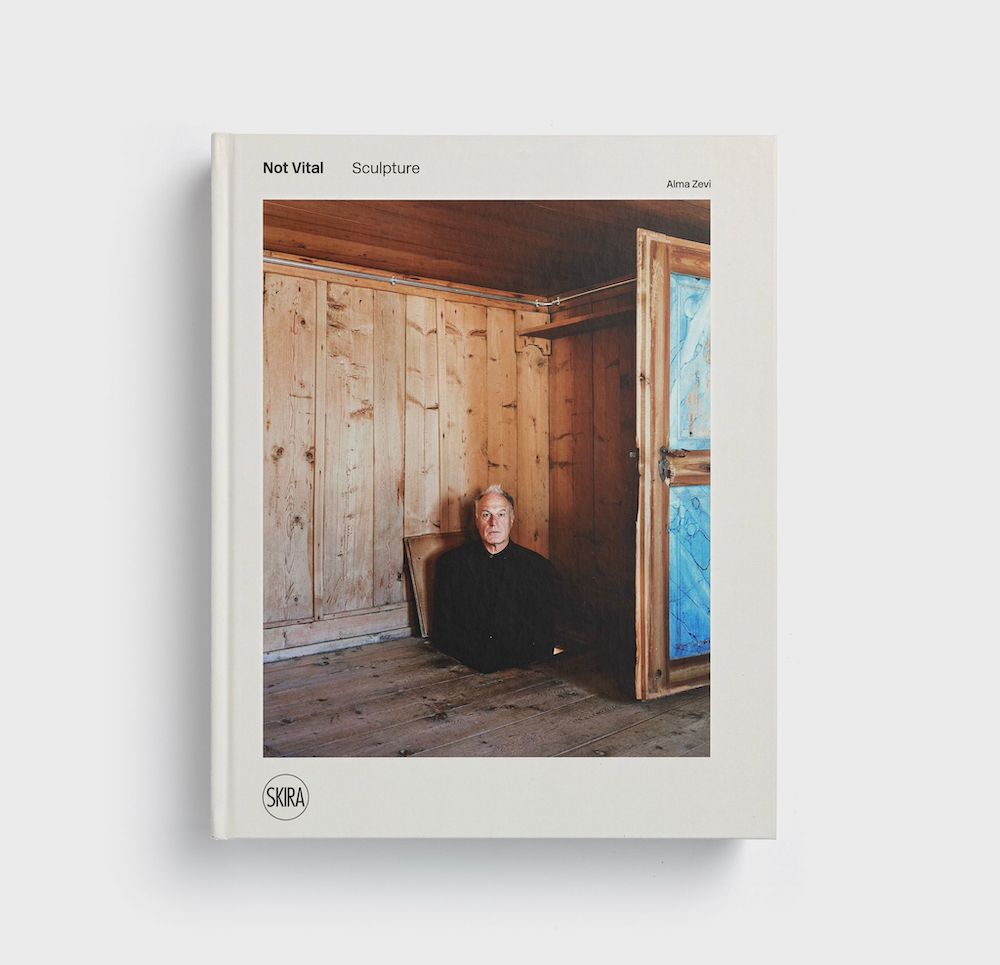 “Not Vital – Sculpture” by Alma Zevi.
“Not Vital – Sculpture” by Alma Zevi.
WHITEWALL: Alma, your first description of Not Vital’s studio in 1998 is so anchored in your inner child’s sensorium that I must ask if you got to ask little Alma what she thought of the book?
ALMA ZEVI: I have the chance now. Little Alma and big Alma are very proud of the book. But not just because it’s a book, because of everything that happened to make it what it is. That’s really special! With Not Vital’s work, it’s like little Alma and big Alma, or little Not and big Not, is all the same, because actually it’s such a playful and exploratory world that Not is creating. And, also I think you [Not] are so connected to your childhood, everything you talked about the habitat and the building… And I feel in this way everyone has the chance to connect to their childhood…
WW: And Not, do you actually remember little Alma in your studio? How do you feel about the way your relationship has evolved from the first time Alma entered your world to today’s conversation?
NOT VITAL: Yes, but it has always been very strong. Even as a child when she walked in the studio, the way she looked at the sculptures was different. I had never seen anyone, let alone a child, look at the work in such a way. She was right there, she knew what she was seeing and what she wanted to see. So it was never really a big surprise to me how things went with us, the surprise was the first impression, it was so strong that afterwards, it was just right.
You know, I like that, I like consistency. With Alma it was always consistent. I like that. And I think it’s the way you can grow better. And I think as I grow older I see how important that is. For example, last week I was with Thaddaeus[Ropac] with the Television, and everyone was excited, but you know, to me it was always the same with him, always consistently very good. Sometimes with some galleries it can be good and it can be bad, you have to deal with it, up and down.
But with Alma, I didn’t know much when you [Alma] were studying in London, I knew you were studying but at that time I didn’t really follow. But it was like she studied and then “Wow” she finished. And it was for what three years?
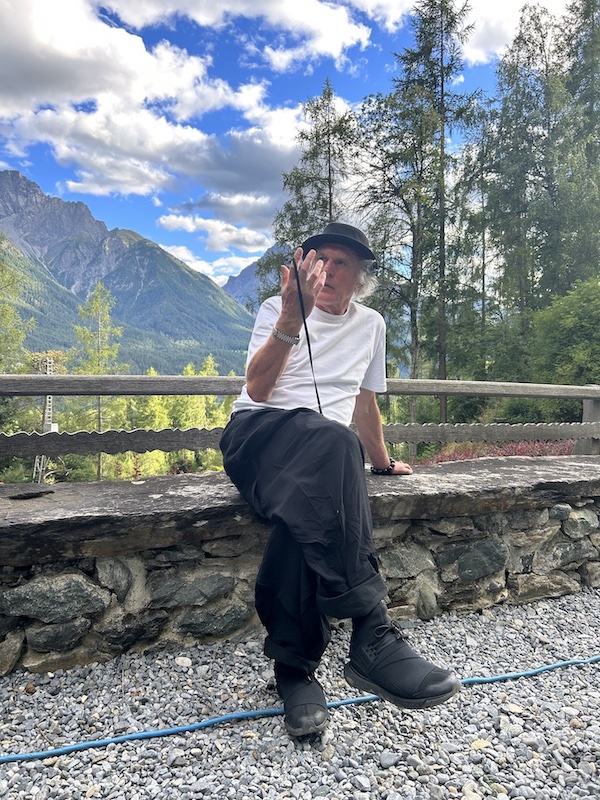 Not Vital in the Sculpture Park.
Not Vital in the Sculpture Park.
AZ: Three years, and before starting university, I interned for Thaddaeus Ropac in Paris and then Salzburg, and I remember it was such a highlight when you came to Paris. Somebody came to see me and told me “Oh, you have a surprise, somebody is here to see you.” And I thought, “Mmm, ok…” but then it was Not, and it was so great!
NV: I once asked Thaddaeus what he thought about Alma, and he said, “That’s easy, she is simply the best!”
WW: And what about the fact that when you, Alma, were studying and trying to find a subject for your thesis, suddenly you had this epiphany that was just in front of you, and decided to do it on Not’s Oeuvre?
AZ: It’s like what Not says as well about Nietzsche, on searching or looking for something. It will just anyway come to you. The finding is there. It was right in front of my eyes, it was absolutely what I wanted to learn more about, and have more experience in.
NV: But another thing is that you don’t have to be constantly in touch. Also, for me, Alma’s mother [artist Marie-Rose Kahane] is someone that even if I don’t see her for half a year, I know she is there. Through time, I would occasionally see you [Alma] or not, but it was always nice. With some other people, you can sometimes have tensions, with people coming from everywhere in the World. For instance in this room (he stands up and points at names engraved around the windows) we had people from China, Brazil, Georgia, and so on. Sometimes to put this together it is not so easy. But having Alma here is like the thing that holds the glass in the window, that keeps things together.
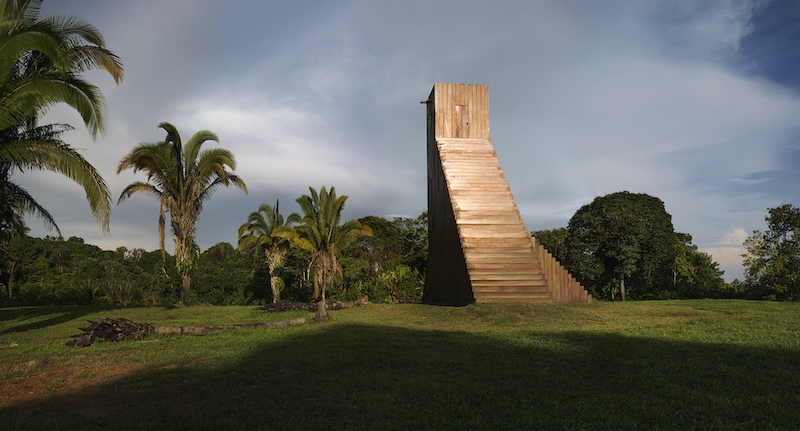 Courtesy of Not Vital.
Courtesy of Not Vital.
“I think that we are not made to stay in one place,” — Not Vital
WW: Your life and practice Not, seem like a perfect blend of nomadic adventures and profound connections to your roots and the lands you touch. How do you feel settled in a constant wandering?
NV: I think that we are not made to stay in one place. We are kind of nomadic by nature, for instance, if I have to think, I’ll take a walk… And then I believe it is easier for me to do that because I live in this place, the Engadin. It’s tremendously important to have a base. It’s extremely important; you build a house, you have a base. So that helped me. You can pretty much go anywhere when you have a base, I think it’s better like that.
You know, when I was in New York for example there were people from Switzerland, from Zurich, that would want to meet at a specific bar, it was their bar because it was similar to the one they were going to in Zurich. They found their own place that they could relate to. But, I wondered why I would go there when I could go to the Bronx. This gives me a certain freedom, but it also goes further back. You know people from the Engadin had to leave to survive, and the same thing is for me too. I knew from the beginning that I couldn’t stay here all the time. I need to leave to come back.
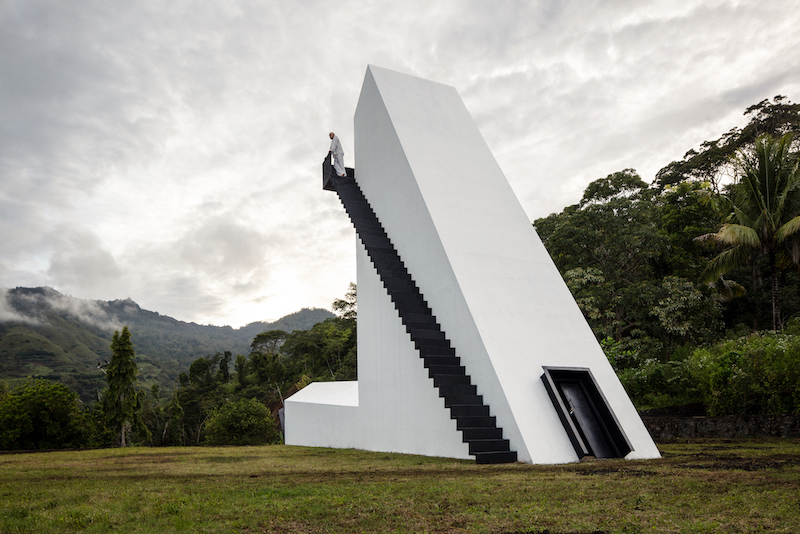 Not Vital’s “House to Watch the Three Volcanoes,” courtesy of the artist.
Not Vital’s “House to Watch the Three Volcanoes,” courtesy of the artist.
WW: So you leave to better come back? For me, for instance, when I left Beirut, I really wanted to leave, but then eventually I realized how much I loved it. It makes you come back with a new perspective, new eyes, because you are enriched with more adventures.
NV: Of course. For instance these mountains [he gestures to the mountains behind him], I always saw them, even before I could walk. I have memories of them since I was very young. But it took me 40 years to make these mountains into sculptures. So, you need to get away in order to see better again.
WW: When do you know it is time to change horizons? What guides you to pick the direction and trajectory? Or is it the smooth result of daydreaming?
NV: It is pretty random, but it has to have two things. One thing is the name for me. In Indonesia, there is an island called Flores. I thought the name was amazing, and I, of course, did not know anything about it, but when I checked it, it had three volcanoes, and these volcanoes were incredible. So I definitely wanted to go to Flores. Same thing with Tonga. It was very random. This is how it happened: We were in New Zealand and we wanted to go the next day to Hong Kong. And in front of me there was a map of that part of the world, with New Zealand in the middle. So I looked at all these islands, and I thought “Wow Samoa, oh wow Tonga.” So it went so fast, we changed the ticket and went there. It is part of the things, not so much research, so you can still get surprised.
WW: Where is Home for you? And what does it actually mean? And as a house builder, if I may say, from where comes the drive to envision and create places to stay? I used to think my home was in my suitcase until quite recently.
NV: Home. If you are five days on this island, Tonga, it’s home. It’s not so much a matter of time though, it’s a matter of heart. Sometimes I like it when it’s new. Tonga, it’s amazing because you are reminded that it is supposed to be “your island” while being constantly surprised and amazed of where you are, actually.
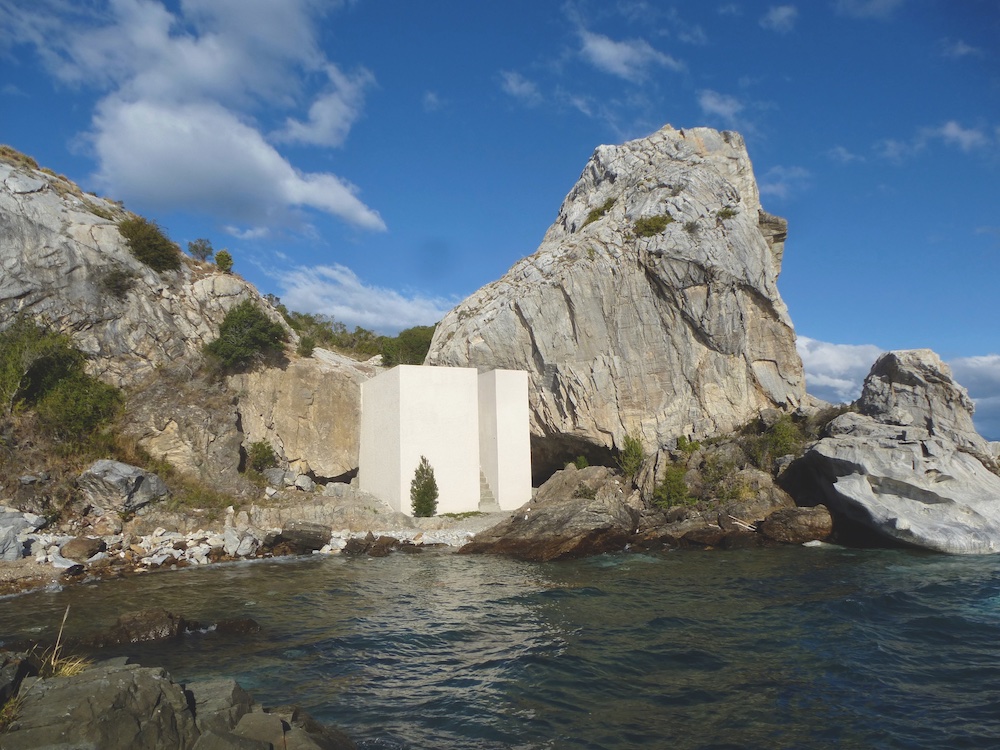 Not Vital’s “NotOna.”
Not Vital’s “NotOna.”
“I like to be amazed,” — Not Vital
WW: Little epiphanies all the time.
NV: Yes, I like to be amazed, not knowing too much about a place.
WW: With works in Niger, the Philippines, the Brazilian Amazon, what is your rapport to conceptions of time and urgency that might inhabit those places, from the ongoing repercussions of global warming in the Amazon to political unrest in Niger?
NV: I am really connected to that. This is how things come together. Another thing that Nietzsche says; if you like something, it’s not in front of your eyes, it’s far away. Even if you are in love with someone, it’s not here, it is far away. Same thing with these places, I feel like it’s very important to go to remote places, because maybe it has to do with the myth, the legend? I think the mythical potential is important to help define where to go.
AZ: I think it’s very interesting that the first thing you built in Niger is a school, thinking of your biography how you said that school was not such an important part of your formation, it was more everything you did on holiday or after school, like looking after the goats, or being in nature and building habitats. And in school it seems you were more disconnected and daydreaming.
NV: Yes! And as you travel to many places, the fastest relationship you build is with children. When I was in Africa, they would ask me “ donnez moi cadeau.” It’s a way of saying “hello” for them. After I built the school, that was the “cadeau.” There are many things you can learn, especially from children. For instance when I built the house to watch the sunset, this kid came and asked why I was there and I said, “Because I am building this house to watch the sunset,” and the kid answered, “Yes, but why? I mean the sunset happens every day.” and I said it was exactly because of that. It is always more direct with kids.
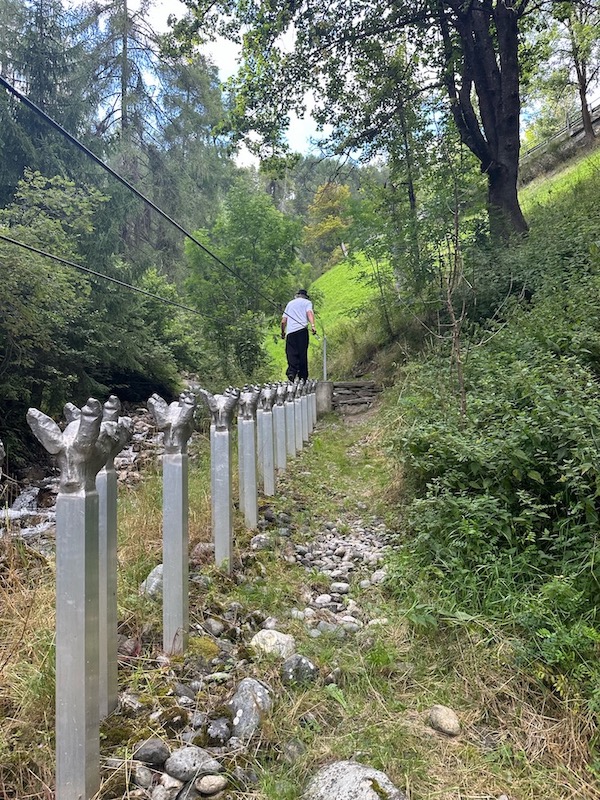 Not Vital on the Donkey Bridge in the Sculpture Park.
Not Vital on the Donkey Bridge in the Sculpture Park.
WW: How did living a nomadic life impact your relationships to friends, movements or groups in general? I know you have encountered in your life many brilliant minds and extraordinary people, but always operated in complete independence.
NV: I think the most important thing about that is the level. As soon as you are the boss they take a position and so do you. And other people have to look up to you. No, that doesn’t work for me. And trust is another thing.
AZ: And that’s the privilege of being an artist and not an architect, you can make sculptures that are building and vice versa, and not having to conform to certain rules and regulations and protocol.
“Art is transformation,” — Not Vital
WW: Transformation is a key aspect of your oeuvre, Not, do you think the very feeling of one’s identity is in perpetual transformation? Coming from a multicultural place such as Switzerland and particularly the Engadin, while being nourished by your world peregrinations, the building and “fortification” of one’s identity can seem rather contradictory with a life in motion or maybe in the contrary quite an organic mixture of movement and fixity?
NV: It’s a combination, it’s both. If you talk about transformation, art is transformation. Especially it took me a long time to understand the connection for example between art, sculpting, painting, and architecture, it’s all related. At the beginning, you always think that to be an architect you do architecture, or to be an artist you do art. But it’s not like that. It takes time to realize it’s all the same. In German, we say “aufpa,” when you make and take care of something. But it can go beyond architecture, beyond art.
AZ: But the question about the evolving identity is really interesting. Are you surprised by how your identity or life evolves? Do you surprise yourself?
NV: I am not that surprised. You know I have the feeling, the idea always that I haven’t done anything. That’s pretty good. One stays a child. For example, buying the Castle of Tarasp, that was a challenge in a way, but not such a big deal. It is more interesting to get it, than owning it. Once you get it, it is not a surprise anymore. Actually, to have a surprise is very difficult.
The other thing is having it and then realizing “wow.” I remember walking around Tarasp and seeing the castle from a particular point, it was so strong. “Wow, and this should be mine? That’s too much.” That is why I did the Foundation. For me, it was important to have it, and then give it, otherwise you become dependent. That was the surprise. That is probably why I still get this energy. Because it is just always the beginning for me.
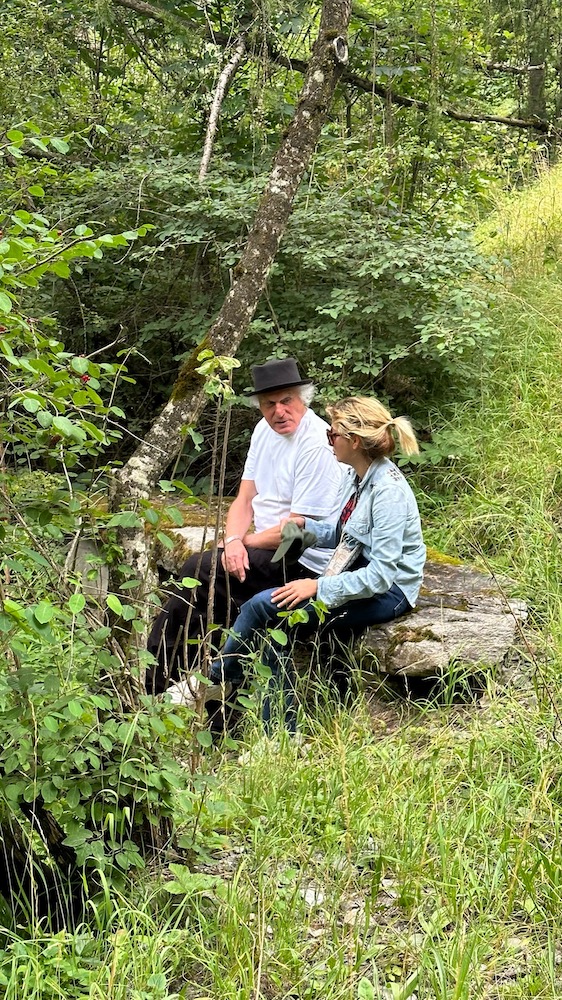 Not Vital and Yasmine Helou in conversation at the Sculpture Park.
Not Vital and Yasmine Helou in conversation at the Sculpture Park.
WW: Alma, being Austrian-Italian and living between Italy, Switzerland, and the UK, how do you think you are building your own identity? The Swiss mountains are the theater of multiple dialects that somehow found a way to coexist and grow harmoniously. Does this sense of peaceful or pacified plurality transpire in the way you both communicate? Be it through sculptures or the written word.
AZ: True. I think for me, as well, the fixed point of reference home, is here in Engadin, because we traveled and lived in different places with my family, but we would always come back here. It started with my grandfather who bought a house here, where my mom grew up. And like you [Not], we stayed during lockdown here for months, and it was absolutely amazing! But it is also better when you have seen other things and then come back, and Not and I always joke, because every time we travel somewhere we always say “Ah that is so beautiful but not as beautiful as the Engadin,” or “This is quite similar to Engadin.” And then, for Notona it was quite incredible because you checked the map, and it was the same distance to the equator as here.
NV: To the millimeter.
AZ: So, it has similar vegetation. There is a very strong connection to this place. And the stable foundation makes you feel comfortable anywhere really, and I think when you are traveling home it is quite flexible. Like tonight after dinner, I will probably say, “ I am so tired I am going to go home.” But that means I am going to go to sleep at the hotel I am staying at. And like you said, home is your suitcase, you feel stimulated and nurtured by traveling, in going places, and seeing things, it’s not tiring or disorienting, you’re just feeding things in.
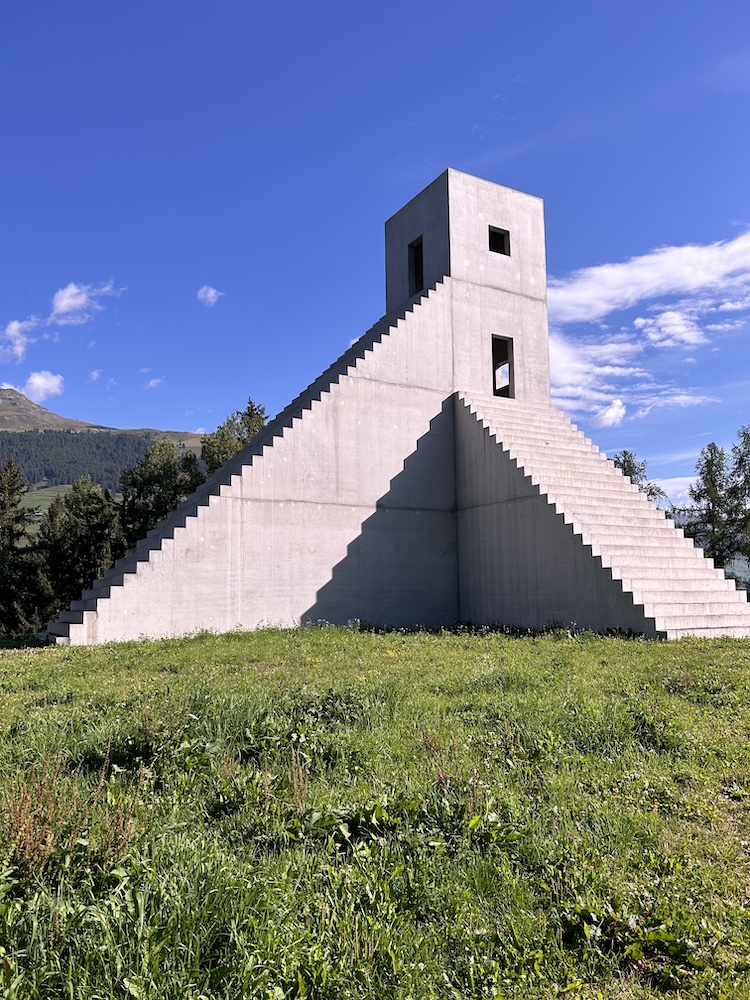 Not Vital’s “House to Watch the Sunset.”
Not Vital’s “House to Watch the Sunset.”
“Everything around here has a beginning and an end. But I thought of the edge that goes through, it is breaking the barriers,” — Not Vital
WW: To me, your outdoor sculptures/architectural pieces or SCARCH can often appear like a metaphysical bridge between the tangible world and the “monde des idées,” claiming a space between earth and air. They inspire elevation and spirituality while being strongly anchored to the land, I wonder if this in-betweenness is a conscious choice?
NV: I was in high school, and I did this show where I put ropes through the house, unlimited ropes and the professor asked, “Is it metaphysical?” And it was a bigger surprise for me that he said that, than for him to see the ropes coming out of the house and disappearing. I just had to come up with something, so I tried to do something that wasn’t limited. Everything around here has a beginning and an end. But I thought of the edge that goes through, it is breaking the barriers.
WW: A bit like the stairs in the sculpture park that goes up and down and you don’t really understand the end or the beginning.
NV: Yes, there is nothing to understand!
WW: Would you agree if I would say you had, and have a quite hectic and full life, and yet, you manage in a way to project a very hermit-like vibe that inspires respect and admiration? I could totally see you as a mysterious storytelling Guru (the good type of Gurus) that wanders the earth leaving his marks (a bit like Senda da Glatsch) and stories everywhere he goes. The question being do gurus leave marks for the future or the present? Is your story horizontal or vertical?
NV: Guru? Well, I would rather say horizontal. Ok, leaving marks! You know in a way you are not aware but you want to leave a scratch more than anything else, that is probably going to happen, you have no control over it. I think in 50 years people will say things about me like, “this guy that lived in this castle and married his horse.”
WW: The legend constructed by the people more than constructed by oneself.
NV: Yes and the remembrance is shorter and shorter. I mean a painting by Tintoretto is worth less than a painting by Cy Twombly.
WW: What a comparison!
NV: I mean, again I always think it is kind of horizontal, it is about consistency.
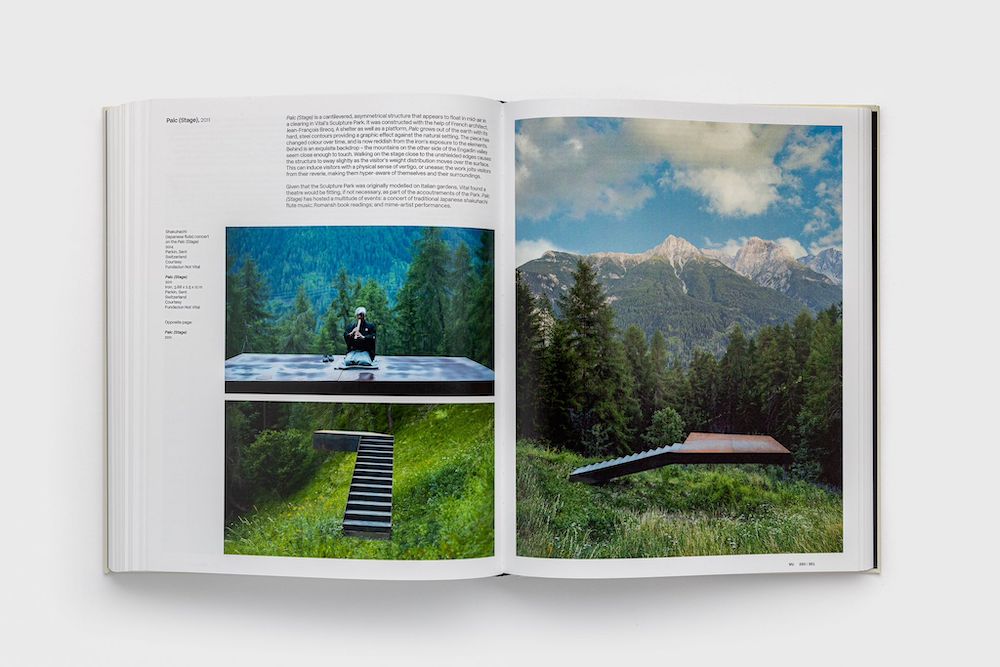 “Not Vital – Sculpture” by Alma Zevi.
“Not Vital – Sculpture” by Alma Zevi.
WW: Alma do you think Not is a guru?
AZ: I think that’s a quite controversial word these days! I think Not is just a unique individual and inspires a lot of people because he is totally uncompromising and makes a lot of impossible things happen. And for a lot of people, it is quite incomprehensible and they can’t imagine of upbeating in that way. So, there is definitely a mythical aura. Even just here locally he is the man who bought the castle and Married the horse! I am sure everywhere you go, like in Niger the man who lost his goats.
NV: There is always an animal!
AZ: In New York you were the man who turned into a donkey. I think there is a performative aspect of the work, it touches a lot of pieces. When you have an extraordinary life, people recognize that, and I find it inspirational and aspirational. And they are just curious.
WW: One last thing, is an empty, unsafe, unfinished building a sculpture?
AZ: You are asking this because it’s not functional?
WW: Exactly!
NV: Makes me think of Matta-Clark who physically cuts through a building just before demolition. It can be a great performative sculpture. A true great transformation!
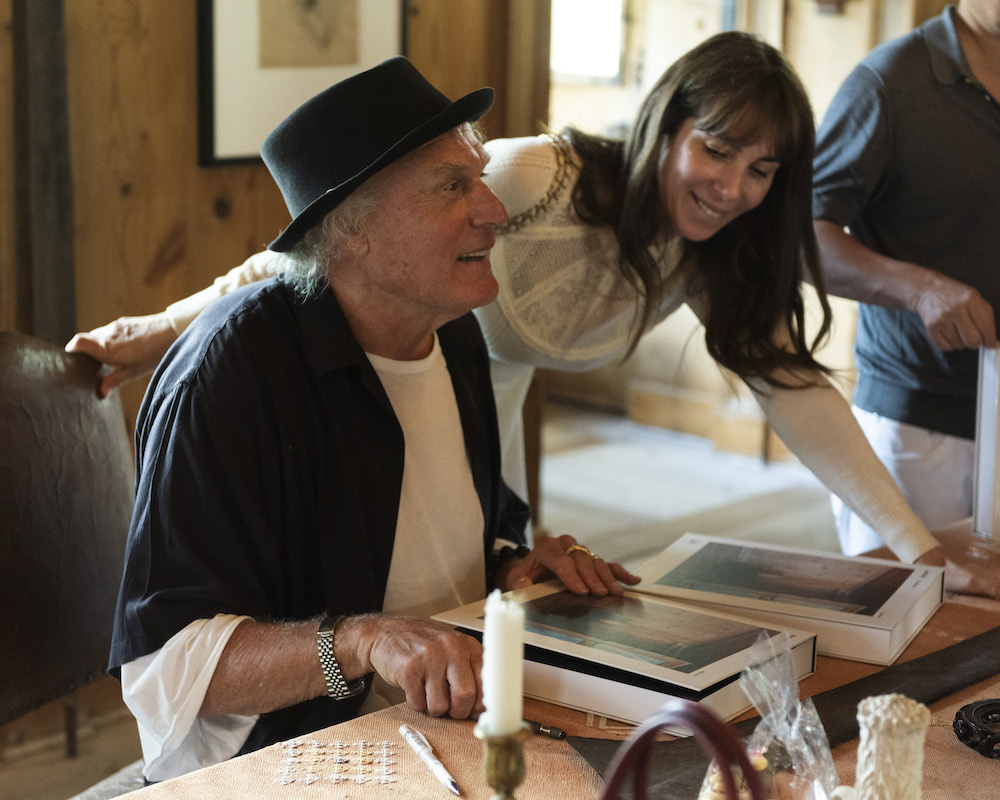 Not Vital book signing.
Not Vital book signing.






